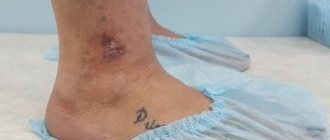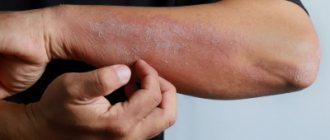Causes of weeping dermatitis
The causes of weeping dermatitis are divided into several points: distant, close, obligate, selective factors.
Remote factors causing the development of the disease:
- Hereditary factor - dermatitis in infants in 40% of manifestations, occurs due to allergies of one or both parents;
- Predisposition – having once contracted any form of weeping dermatitis, 50% of patients remain sensitive to the disease;
- Low immunity;
- Acute and chronic diseases of internal organs;
Related factors that can trigger the development of the disease:
- Psychological illnesses, prolonged stress, nervousness - very often a strong nervous shock can cause a decrease in the body’s protective functions and, as a result, a decline in immunity.
- The entry of pathogenic substances into the human body - allergens, chemicals that have a detrimental effect on the skin.
- Diseases of the stomach and/or intestines - improper functioning or malfunction of these organs is the most common cause of weeping dermatitis.
Obligate factors (arising under the influence of external factors):
- Pathogenic radiation - radiation, prolonged exposure to direct sunlight;
- Overheating or, on the contrary, hypothermia of the body;
- Contact with chemicals – acid or alkali.
Selective factors:
- Allergy – food (to food or medicine);
- Allergies - to cosmetics, insect bites;
Weeping dermatitis is essentially an advanced stage of any other type of dermatitis (domestic, occupational, fungal, bacterial), in addition to the above, can occur as a result of improperly selected treatment or ignoring the disease.
Symptoms of weeping dermatitis
Symptoms of the disease may vary, depending on the age of the patient.
In adults, lesions form in natural folds of the skin, on the face and neck, arms and legs. A rash and erythema (redness) with cloudy contents appear; as the disease progresses, the rash opens, forming weeping erosions.
Common symptoms can be identified for all ages: swelling and redness of the skin at the locations of the lesions, the presence of a rash with cloudy contents.
The disease is characterized by severe itching - its intensity is influenced by the severity of damage to the nerve endings located in the skin; burning and painful sensations, a feeling of dryness or tightness; in addition, a person experiences emotional discomfort, since dermatitis has an unpleasant appearance.
Weeping dermatitis, if not properly treated, can have complications - damage to large areas of the skin, discharge of purulent contents (in cases of infection), and in rare cases, sepsis (blood poisoning) is possible.
You can see what weeping dermatitis looks like in the photo section.
Symptoms and diagnosis
Weeping dermatitis forms in the deep layers of the skin. Inflammation and swelling form in the affected area, then ulcers and cracks appear. Liquid is released - exudative or purulent.
The patient feels a painful itching, against which mild neurological disorders may develop. Sleep is disturbed and appetite disappears. When scratching the ulcers, infection may occur, which worsens the general condition, causing fever.
Weeping dermatitis in a child
The occurrence of weeping dermatitis in children is due to the characteristics of the skin; at an early age, the skin does not have the same protective forces as the skin of an adult and is therefore more susceptible to the influence of pathogenic factors. The second reason may be weak immunity; children suffer from respiratory diseases more often than adults, and are more susceptible to the negative effects of external factors than adults.
Signs of the disease in children may vary depending on the age of the child:
Weeping dermatitis in infants often occurs on the bends of the elbows, knees and face, and very rarely occurs on other areas of the skin. Small cracks and ulcers may appear on the dermis; after a few days, crusts form on the affected areas.
In children over three years of age, lesions are localized on the hands, elbows, knees and neck. The skin in the affected areas is inflamed - swollen and acquires a bright red color, cracks and ulcers form, and the course of the disease is long. Subsequently, the skin at the former sites of outbreaks thickens and differs from healthy skin in a dark shade.
In adolescents, the disease proceeds in the same way as in children over three years of age, the only difference is the spontaneous course; there may be a sharp development or an independent decline in symptoms. With a sharp exacerbation of the disease, lesions can occupy large segments of the skin.
In the photo section, you can see what weeping dermatitis looks like in children.
Treatment of weeping dermatitis
Before starting treatment, it is necessary to conduct a diagnosis. Diagnosis is very important, since weeping dermatitis has a similar clinical picture to eczema; this is usually not difficult for a specialist, but for an accurate diagnosis, the specialist conducts the following studies:
- Scraping - to exclude other skin diseases and identify the possible causative agent of the disease;
- Tests to identify allergies and the source of allergies;
- A general blood and urine test is used to determine the cause of dermatitis and identify concomitant diseases.
Often, treatment involves complex therapy, which is aimed at eliminating the cause of weeping dermatitis and relieving the symptoms characteristic of it.
- Antihistamines (anti-allergic) drugs to relieve itching and swelling of tissues;
- Sometimes sorbents may be indicated (if dermatitis occurs due to allergies);
- Prebiotics to normalize intestinal microflora;
- Antibiotics - in case of secondary infection (when scratching, often in children)
- Local preparations for eliminating the inflammatory process, relieving the sensation of itching and for rapid tissue regeneration; a popular drug that copes with these purposes is Losterin.
- Antiseptic solutions are used to treat lesions when opening pustules (rashes).
- Severe itching can cause sleep disturbances and affect mental health, in these cases sedatives are indicated.
In addition to medications, it is recommended to follow a diet; this is one of the factors contributing to a rapid recovery. The diet involves eliminating foods that can cause allergic reactions (citrus fruits, nuts, honey, etc.).
For weeping dermatitis in infants, special attention is paid to correcting nutrition and following the mother’s diet if she is breastfeeding.
When weeping dermatitis passes into the chronic stage, medications are indicated to raise and strengthen the immune system.
Self-medication in this case is unacceptable, especially in relation to the treatment of children. The doctor prescribes medications based on test results and taking into account the characteristics of the body.
Treatment and prevention
To treat diaper rash, it is important to find out the cause of its occurrence and remove it.
- During a shower or bath, pay special attention to the affected areas; the soap solution has a good drying effect.
- After hygiene procedures, the body should be well dried and you can take an air bath for 10-15 minutes.
- Bed and underwear should always be clean, without wrinkles and made from natural fabrics.
- Areas of diaper rash are treated with an antiseptic (chlorhexidine, furatsilin), and then wound-healing ointments (Bepanten, Dexapanthenol) can be applied.
- Antiseptic can be applied up to 7 times a day, and ointments can be applied 2-3 times a day.
- Herbal medicine has a very good effect both in treatment and in prevention: a decoction of oak bark, chamomile, and celandine. They can be used topically and added to baths. The duration of herbal medicine can reach up to 3 weeks.
- Economical products include zinc ointment, Teymurov's paste and simple talc.
- Antihistamines can relieve itching (tavegil, suprasin).
- If secondary infections are already attached, they may prescribe a scraping from the site of the lesion, which will help determine additional treatment methods (antifungals, antibiotics).
But do not forget that a disease is easier to prevent than to treat. Basic rules of prevention:
- Take a shower or bath at least once;
- The body should be dry after a shower or bath;
- Clothes and shoes should not fit tightly or rub;
- Reduce the risk of overheating;
- Monitor your health carefully. Especially for diseases that provoke increased sweating;
- Food should be varied, nutritious and fortified.
ONLINE REGISTRATION at the DIANA clinic
You can make an appointment by calling the toll-free phone number 8-800-707-15-60 or filling out the contact form. In this case, we will contact you ourselves.
Treatment of weeping dermatitis with folk remedies
Traditional medicine has many recipes to combat various dermatological pathologies. Methods of therapy may include tinctures, lotions, ointments, etc., based on herbs or other natural ingredients, but these remedies are ineffective or not effective at all. Herbal medicine can relieve some symptoms, but will not have a detrimental effect on the cause of dermatitis, and in some cases it will worsen the disease. Some traditional medicines can be used as an addition to the main treatment and should only be reported to a doctor. You should not prescribe any folk remedies yourself, especially if a child needs help.
Differential diagnosis
Many skin diseases are accompanied by itching, hyperemia, and rash. A doctor can distinguish them, after which suitable treatment will be prescribed. Contact dermatitis may resemble:
- atopic dermatitis;
- eczema;
- psoriasis;
- lichen planus;
- scabies;
- dermatophytosis.
To differentiate skin pathologies, the body is examined:
- examination of the skin with magnification;
- specific samples;
- scraping and examination under a microscope;
- blood tests, urine tests, biochemistry, hormonal examinations.
There are common diseases in which dermatitis also occurs, but there are also other clinical symptoms:
- phenylketonuria;
- porphyria;
- acrodermatitis against the background of enteropathy.
In this case, you need to treat the underlying disease, then the skin manifestations will go away.
Treatment of weeping dermatitis with Losterin
Improper skin care for dermatological diseases slows down recovery, so it is important to choose products suitable for problem skin that do not dry out, but at the same time cleanse. A common product is Losterin gel for showering or Losterin cream for skin care. Thanks to its composition, it protects the skin from dryness and cracks, helps reduce flaking and has a regenerating effect. Used for the treatment and prevention of weeping dermatitis.
Causes of diaper rash in newborns
The main reason why newborn babies are most susceptible to diaper rash is the structure of their skin. The lipid barrier on its surface is still very thin and sensitive to any aggressive external influences, and the stratum corneum is 30% thinner than that of an adult.
As a result, the protective properties of the skin can be destroyed due to temperature changes, frequent bathing, and the use of hygiene products that are not intended for children's skin.
Prevention of weeping dermatitis
It is easier to prevent any disease than to treat it, tinea versicolor is no exception, in order to avoid the development of the disease you should:
- Adhere to the rules of proper nutrition - to prevent diseases of the stomach and intestines;
- Treat acute and chronic diseases - they are often the main cause of reduced immunity;
- Maintain immunity, especially after illnesses, in the autumn-spring period, after long-term use of strong medications;
- For people prone to allergies, exclude allergens;
- Avoid stress, maintain psychological health, and consult a specialist if necessary.
If dermatitis does appear, then for a quick recovery and to prevent recurrence of the disease, you should:
- Follow the recommendations of your doctor, do not interrupt or stop treatment without consulting a doctor;
- Compliance with hygiene rules, proper treatment of affected skin areas;
- Avoid sources that provoke allergies.
Exclude pathogenic factors.
If symptoms indicating weeping dermatitis appear, you should immediately consult a doctor, this will allow you to start treatment on time, which will have a beneficial effect on the duration of therapy and reduce the risk of developing negative consequences and relapses.
Skin care
In order to prevent an increase in the area of development of weeping dermatitis, various treatment preparations are used. For purulent discharge, 3% hydrogen peroxide can be used for cleansing, followed by drying the surface, then treated with brilliant green (green in common parlance).
This prevents infections from scratching. Hormonal ointments are prescribed - Akriderm, Flucinar, Sinaflan and others. They relieve swelling and reduce the reaction to allergens. Basic hygiene is definitely important. If we are talking about a child, daily bathing in medicinal solutions is mandatory.








